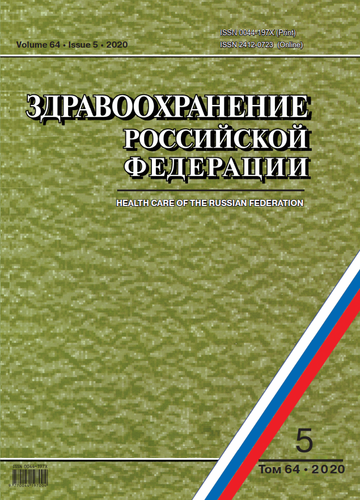Pharmacoeconomic analysis of the management of glaucoma with prostaglandin analogs
- Authors: Kornilova E.B.1, Polyakova K.I.1, Zavyalov A.A.1, Ermolaeva T.N.2
-
Affiliations:
- Research Institute for Healthcare Organization and Medical Management of Moscow Healthcare Department
- Clinical and Economic Analysis Scientific-Practical Center of the Moscow Region Healthcare Ministry»
- Issue: Vol 64, No 5 (2020)
- Pages: 258-263
- Section: HEALTH CARE ORGANIZATION
- Submitted: 25.10.2024
- URL: https://rjonco.com/0044-197X/article/view/637935
- DOI: https://doi.org/10.46563/0044-197X-2020-64-5-258-263
- ID: 637935
Cite item
Full Text
Abstract
Introduction. Prevention and treatment of glaucoma, which threatens the development of blindness, is one of the most important medical and social problems facing modern society in the era of value-based health care. However, against the background of a wide selection of prostaglandin-F2α analogs, which have an approximately similar level of decrease in ophthalmotonus, a clinical and economic argumentation is required for the approach when forming a budget for drug treatment of glaucoma.
The aim of the study. To assess the burden on the health budget of the city of Moscow when using the fluorinated prostaglandin-F2α analog as compared to other prostaglandin-F2α analogs for the treatment of adult patients with primary open-angle glaucoma.
Material and methods. There was studied data on the population of patients with a diagnosis of «glaucoma» receiving medication from the budgetary funds of the city of Moscow. The direct medical costs of healthcare in Moscow were calculated for preparations of prostaglandin-F2α analogs for the treatment of adult patients with primary open-angle glaucoma in various clinical options for 5 years.
Results. The use of the fluorinated prostaglandin-F2α analog drug Tafluprost in patients with primary open-angle glaucoma is economically justified, while budget savings in the 5-year horizon amounted to 196,777,224.60 rubles, 12,295,378.28 rubles in the baseline scenario (default appointment). and 116 084 865.02 rubles, and in alternative scenarios (appointment for adverse events on Latanoprost) - 125 113 646.70 rubles, 43 942 565.04 rubles. and 89,609,415.58 rubles, respectively.
Conclusion. The inclusion of the drug Tafluprost in the drug supply programs of the Moscow healthcare system will increase the efficiency of the use of financial resources and increase the availability of drug supply.
About the authors
Ekaterina B. Kornilova
Research Institute for Healthcare Organization and Medical Management of Moscow Healthcare Department
Author for correspondence.
Email: ekaterinakornilova2017@gmail.com
ORCID iD: 0000-0002-7214-4340
MD, Ph.D., Leading Researcher, Research Institute of Health Organization and Medical Management of Moscow Healthcare Department, Moscow, 115088, Russia.
e-mail: ekaterinakornilova2017@gmail.com
Russian FederationKseniya I. Polyakova
Research Institute for Healthcare Organization and Medical Management of Moscow Healthcare Department
Email: noemail@neicon.ru
ORCID iD: 0000-0002-8462-2813
Russian Federation
Aleksandr A. Zavyalov
Research Institute for Healthcare Organization and Medical Management of Moscow Healthcare Department
Email: noemail@neicon.ru
ORCID iD: 0000-0003-1825-1871
Russian Federation
Tat’yana N. Ermolaeva
Clinical and Economic Analysis Scientific-Practical Center of the Moscow Region Healthcare Ministry»
Email: noemail@neicon.ru
ORCID iD: 0000-0002-3615-0292
Russian Federation
References
- European Glaucoma Society Terminology and Guidelines for Glaucoma, 4th Edition – Chapter 3: Treatment principles and options Supported by the EGS Foundation: Part 1: Foreword; Introduction; Glossary. Br. J. Ophthalmol. 2017; 101(6): 130–95. https://doi.org/10.1136/bjophthalmol-2016-egsguideline.003
- WHO. World Report on Vision; 2019. Available at: https://www.who.int/publications/i/item/world-report-on-vision
- Astakhov S.Yu., Tkachenko N.V. Taflotan, the first preservative-free prostaglandin f2α analogue: treatment advantages in primary open-angle glaucoma patients. Oftal’mologicheskie vedomosti. 2016; 9(2): 59–68. https://doi.org/10.17816/OV9259-68 (in Russian)
- Korotkikh S.A., Borzunov O.I. Tafluprost in patients with moderate- and advanced-stage primary open-angle glaucoma. Klinicheskaya oftal’mologiya. 2015; 15(4): 176–80. (in Russian)
- Petrov S.Yu., Safonova D.M. Tafluprost – the first preservative-free prostaglandin analogue. Klinicheskaya oftal’mologiya. 2014; 14(3): 166–71. (in Russian)
- Boland M.V., Ervin A.M., Friedman D.S., Jampel H.D., Hawkins B.S., Vollenweider D., et al. Comparative effectiveness of treatments for open-angle glaucoma: a systematic review for the U.S. Preventive Services Task Force. Ann. Intern. Med. 2013; 158(4): 271–9. https://doi.org/10.7326/0003-4819-158-4-201302190-00008
- Astakhov S.Yu., Tkachenko N.V. Taflotan, the first preservative-free prostaglandin f2α analogue: treatment advantages in primary open-angle glaucoma patients. Oftal’mologicheskie vedomosti. 2016; 9(2): 59–68. https://doi.org/10.17816/OV9259-68 (in Russian)
- Holownia-Voloskova M., Vorobiev P.A., Grinin M., Davydovskaya M.V., Ermolaeva T.N., Kokushkin K.A. Drug policy in the Russian Federation. Value Health Reg. Issues. 2018; 16: 106–11. https://doi.org/10.1016/j.vhri.2018.09.001
- Egorov E.A., Astakhov Yu.S., Erichev V.P., eds. National Glaucoma Guide for Practitioners [Natsional’noe rukovodstvo po glaukome dlya praktikuyushchikh vrachey]. Moscow: GEOTAR-Media; 2015. (in Russian)
- Kapetanakis V.V., Chan M.P., Foster P.J., Cook D.G., Owen C.G., Rudnicka A.R. Global variations and time trends in the prevalence of primary open angle glaucoma (POAG): a systematic review and meta-analysis. Br. J. Ophthalmol. 2016; 100(1): 86–93. https://doi.org/10.1136/bjophthalmol-2015-307223
- Vorob’ev P.A., ed. Clinical and Economic Analysis [Kliniko-ekonomicheskiy analiz]. Moscow: N’yudiamed; 2008. (in Russian)
- GOST R56044-2014. Assessment of medical technology. Moscow; 2014. (in Russian)
- Uusitalo H., Pillunat L.E., Ropo A.; Phase III Study Investigators. Efficacy and safety of tafluprost 0.0015% versus latanoprost 0.005% eye drops in open-angle glaucoma and ocular hypertension: 24-month results of a randomized, double-masked phase III study. Acta Ophthalmol. 2010; 88(1): 12–9. https://doi.org/10.1111/j.1755-3768.2010.01862.x
- Hommer A., Kimmich F. Switching patients from preserved prostaglandin-analog monotherapy to preservative-free tafluprost. Clin. Ophthalmol. 2011; 5: 623–31. https://doi.org/10.2147/opth.s17876
- Janulevičienė I., Derkač I., Grybauskiene L., Paulauskaitė R., Gromnickaite R., Kuzmienė L. Effects of preservative-free tafluprost on tear film osmolarity, tolerability, and intraocular pressure in previously treated patients with open-angle glaucoma. Clin. Ophthalmol. 2012; 6: 103–9. https://doi.org/10.2147/opth.s28104
- Uusitalo H., Chen E., Pfeiffer N., Brignole-Baudouin F., Kaarniranta K., Leino M., et al. Switching from a preserved to a preservative-free prostaglandin preparation in topical glaucoma medication. Acta Ophthalmol. 2010; 88(3): 329–36.
Supplementary files










